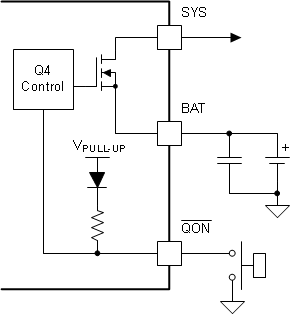SLUSDA2B July 2018 – February 2022 BQ25601D
PRODUCTION DATA
- 1 Features
- 2 Applications
- 3 Description
- 4 Revision History
- 5 Description (continued)
- 6 Device Comparison Table
- 7 Pin Configuration and Functions
- 8 Specifications
-
9 Detailed Description
- 9.1 Overview
- 9.2 Functional Block Diagram
- 9.3 Feature Description
- 9.4 Device Functional Modes
- 9.5 Protections
- 9.6 Programming
- 9.7
Register Maps
- 9.7.1 REG00 (address = 00) [reset = 00010111]
- 9.7.2 REG01 (address = 01) [reset = 00011010]
- 9.7.3 REG02 (address = 02) [reset = 10100 010]
- 9.7.4 REG03 (address = 03) [reset = 001 0001 0]
- 9.7.5 REG04 (address = 04) [reset = 01011000]
- 9.7.6 REG05 (address = 05) [reset = 10011111]
- 9.7.7 REG06 (address = 06) [reset = 01100110]
- 9.7.8 REG07 (address = 07) [reset = 01001100]
- 9.7.9 REG08 (address = 08) [reset = xxxxxxxx]
- 9.7.10 REG09 (address = 09) [reset = xxxxxxxx]
- 9.7.11 REG0A (address = 0A) [reset = xxxxxx00]
- 9.7.12 REG0B (address = 0B) [reset = 00111xxx]
- 10Layout
- 11Device and Documentation Support
Package Options
Mechanical Data (Package|Pins)
- RTW|24
Thermal pad, mechanical data (Package|Pins)
- RTW|24
Orderable Information
9.4.4.4 QON Pin Operations
The QON pin incorporates two functions to control BATFET.
- BATFET Enable: A QON logic transition from high to low with longer than tSHIPMODE deglitch turns on BATFET and exit shipping mode. When exiting shipping mode, HIZ is enabled (EN_HIZ = 1) as well. HIZ can be disabled (EN_HIZ = 0) by the host after exiting shipping mode. OTG cannot be enabled (OTG_CONFIG = 1) until HIZ is disabled.
- BATFET Reset: When QON is driven to logic low by at least tQON_RST while adapter is not plugged in (and BATFET_DIS = 0), the BATFET is turned off for tBATFET_RST. The BATFET is re-enabled after tBATFET_RST duration. This function allows systems connected to SYS to have power-on-reset. This function can be disabled by setting BATFET_RST_EN bit to 0.
Figure 9-10 shows the sample external configurations for each.
 Figure 9-10 QON Timing
Figure 9-10 QON Timing Figure 9-11 QON Circuit
Figure 9-11 QON Circuit